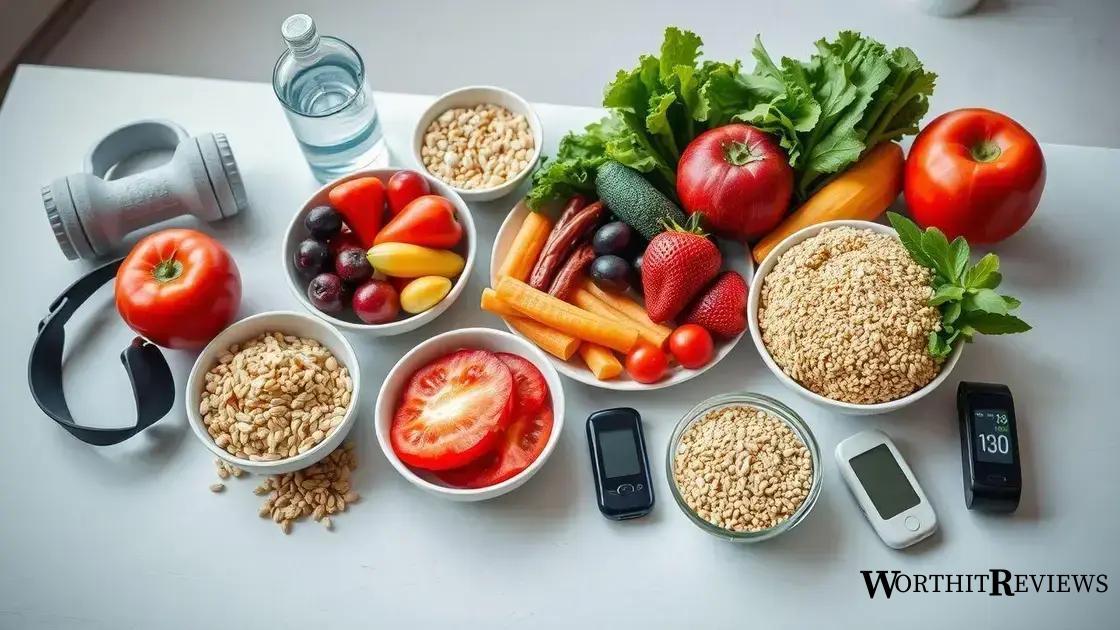Blood glucose results reveal essential information about your health, influenced by diet, exercise, and effective monitoring tools like glucometers and continuous glucose monitors, enabling better management of blood sugar levels.
Blood glucose results can tell you a lot about your health. But do you truly understand what those numbers mean? Let’s explore how to make sense of them and why it’s crucial for your wellbeing.
What do blood glucose results indicate?
Blood glucose results are crucial for understanding how your body processes sugar. These numbers can indicate your overall metabolic health and even unveil early signs of diabetes. Knowing what these results mean empowers you to make informed decisions about your health.
Understanding the Numbers
Typically, blood glucose levels are measured in milligrams per deciliter (mg/dL). A normal fasting blood glucose level is usually between 70 and 100 mg/dL. Levels above this range may suggest prediabetes or diabetes. It’s essential to know where you stand to manage your well-being effectively.
Interpreting High Blood Glucose Levels
Results above 126 mg/dL suggest that you might have diabetes. High levels can occur after eating, but consistently elevated readings should prompt further testing and discussion with a healthcare professional. It’s vital to recognize symptoms of high blood sugar, which can include increased thirst, frequent urination, and fatigue.
What Low Blood Glucose Levels Mean
If your blood glucose levels drop below 70 mg/dL, you could be experiencing hypoglycemia. Symptoms may include dizziness, shaking, or confusion. Identifying the cause of low blood sugar is crucial, as it may occur due to medication mismanagement or inadequate food intake.
Monitoring Your Results
Regularly tracking your blood glucose levels can provide valuable insights into your overall health. Using tools like glucometers or continuous glucose monitors (CGMs) can help you stay informed and act accordingly to maintain balanced levels.
How to maintain optimal blood glucose levels

Maintaining optimal blood glucose levels is essential for overall health. Here are effective strategies to help you keep your blood sugar in check while feeling your best.
Balanced Diet is Key
Eating a diet rich in whole foods can significantly impact your blood glucose levels. Focus on incorporating high-fiber foods like fruits, vegetables, whole grains, and legumes. These foods help slow down digestion and keep your blood sugar stable.
Portion Control
Monitoring portion sizes can also aid in regulating blood glucose. Consuming smaller meals more frequently helps maintain steady energy levels and prevents spikes in blood sugar. Use small plates and pay attention to serving sizes to avoid overeating.
Regular Exercise
Engaging in regular physical activity is crucial for managing blood sugar levels. Aim for at least 30 minutes of moderate exercise most days of the week. Activities like brisk walking, swimming, or cycling can help improve your body’s sensitivity to insulin.
Stay Hydrated
Drinking plenty of water is essential for optimal blood glucose control. Staying hydrated helps kidneys flush out excess sugar through urine. Aim for 8 cups of water a day, and consider reducing sugary beverages that can spike your blood sugar.
Regular Monitoring
Keeping track of your blood glucose levels is important. Use a glucometer to check your levels regularly, especially if you’re managing diabetes. Understanding your body’s patterns helps identify what foods and activities impact your glucose.
The impact of diet on blood glucose results
Your diet plays a vital role in the management of blood glucose results. Different foods affect blood sugar in various ways, and understanding these impacts can help you make better choices.
Carbohydrates and Blood Sugar
Carbohydrates are broken down into sugar in the body. Foods high in simple carbohydrates, like candy and white bread, can cause quick spikes in blood glucose. In contrast, complex carbohydrates, found in whole grains and beans, digest slower, providing a more stable energy release.
The Role of Fiber
Fiber is essential for blood glucose control. High-fiber foods, such as vegetables, fruits, and whole grains, help slow digestion and prevent rapid spikes in blood sugar after meals. Aim to include 25 to 30 grams of fiber in your daily diet for optimal health.
Healthy Fats
Incorporating healthy fats into your meals can also be beneficial. Foods rich in monounsaturated fats, like avocados and nuts, can improve insulin sensitivity, helping your body use blood sugar more effectively. This can lead to better overall blood glucose results.
Protein’s Role
Protein is another important nutrient that can help stabilize blood sugar. Consuming protein with carbohydrates can slow down the absorption of sugar. Consider adding sources like chicken, fish, eggs, or legumes to your meals to enhance blood sugar control.
Hydration Matters
Staying hydrated is crucial for overall health and can influence blood glucose levels. Drinking water helps your kidneys flush out excess sugar through urine. Aim for at least 8 cups of water each day, and limit sugary drinks that can cause spikes in blood glucose.
Tools for monitoring blood glucose effectively

Monitoring blood glucose effectively is vital for managing health, especially for those with diabetes. Various tools are available to help individuals keep track of their levels with ease.
Glucometers
Glucometers are the most common tools for checking blood sugar levels at home. These devices require a small blood sample, usually from a fingertip, to provide quick readings. Look for glucometers that come with memory functions, allowing you to store previous readings for better tracking.
Continuous Glucose Monitors (CGMs)
CGMs offer a more advanced way to monitor blood sugar levels. These devices are worn on the skin and provide real-time glucose readings throughout the day. CGMs alert users if their blood sugar levels are getting too high or too low, which can be very helpful for maintaining optimal levels.
Mobile Apps
Many mobile applications are available that can help you log your blood glucose readings. These apps often allow you to track food intake, physical activity, and medication, providing a comprehensive view of patterns over time. Some apps can sync with glucometers and CGMs for seamless tracking.
Smart Insulin Pens
Smart insulin pens come equipped with technology to help track doses and timing. They can connect to your smartphone, allowing for better tracking of insulin administration, making it easier to manage your blood glucose levels effectively.
Blood Ketone Meters
For individuals following a low-carb or ketogenic diet, blood ketone meters can be used to measure ketone levels in the blood. These meters are helpful for determining how effectively your body is metabolizing fats for energy, which can influence blood glucose levels.
Understanding Blood Glucose Management
Managing your blood glucose levels is essential for maintaining good health. By knowing what affects your levels, such as diet and exercise, you can take charge of your well-being.
Utilizing tools like glucometers and mobile apps can make tracking your readings easier. It’s about making informed decisions to keep your blood sugar stable.
Always consult with healthcare professionals to find the best strategies for your individual needs. With the right knowledge and tools, you can effectively manage your blood glucose and improve your quality of life.
